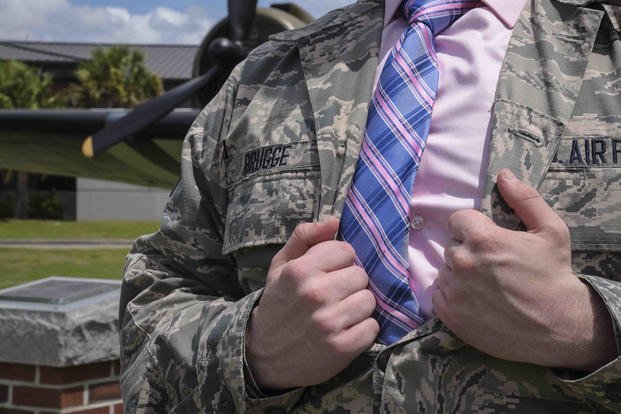If you've spent your working life in the military, you probably have not had to make daily wardrobe decisions. You wore a uniform. It may surprise you to learn that there are civilian "uniforms," too. You must learn what "uniform" will help you get that important job and fit in well in your new office. Follow these "Dress for Success" tips and learn how to dress like a pro.
What Your Clothes Say
You may be heartened to know that after 20 years, your brown polyester-blend suit still fits. But that doesn't mean you should wear it to an interview. It will make you look old, like you don't "keep up" or can't adjust to change. Employers may be afraid to take a chance on such a person in today's fast-paced, youthful work environment.
Likewise, you may just love the way you look in your double-breasted, mustard-colored, rayon/silk blend suit. Nevertheless, it is appropriate for a disco ... not a job interview. Flashy clothing and jewelry can make you appear vain or like you're not serious about work. That is certainly not the impression you wish to make if you are applying for a position that requires responsibility. Separate "club clothes" from "work clothes."
Though there is a growing movement to adopt business casual dress standards, many companies still expect professional attire. You may feel tempted to wear your everyday clothing to an interview. Perhaps you don't wish to "put on airs" or you want to show "the real you."
In most cases, however, you shouldn't wear jeans and a sweater to a job interview unless that is the uniform for the profession. Employers could construe that you just don't care whether you get the job or that you lack commitment. That is not the attitude you wish to project to employers who will spend considerable time and money on your training and development.
Before you interview with a company, you should spend some time looking at the people who work there. Although the company may not issue required clothing, you're bound to find similarities in the way people dress. Perhaps you'll find that everyone seems to wear khaki chinos and a polo shirt.
Ask the human resources director or your interviewer, in advance, what attire is expected at the interview -- professional or business casual. Remember, your aim is to establish credibility and fit in.
Interview Dress Checklist
You may have many interviews during your job search. One good suit -- your "interview suit" -- is all you need.
The first rule is excellent quality. It must stand up to wear and tear. As a rule, a good suit from a reputable national clothing store or a department store such as Jos. A. Bank Clothiers should cost between $450 and $1,000.
"Designer" suits usually fall into the $500-$1,000 range. A designer label is not a priority when selecting a suit. (Moreover, you would not want to "outdress" the interviewer and look like you don't need the job.) Quality is your priority.
Calculate what you can afford to spend. For men, don't forget that you will need at least two dress shirts, a tie, a belt and shoes. For women, you'll need at least two blouses, undergarments, hosiery and a pair of pumps.
An expenditure of $300 for a men's suit is not unreasonable. However, a poor quality suit that costs $300 is not a good deal. It would be far better to go to a fine store, select a $450 suit and wait until it goes on sale for $300. Ask an experienced sales associate or tailor to help you select a suit; don't rely on your spouse or friend.
Most men can't buy a suit "off the rack" and wear it away. Good stores offer tailoring. Sleeve lengths and waistbands need to be altered. All new suits will need to be hemmed to your inseam.
Checklist for Men
When selecting your suit, keep these factors in mind:
- The color should be very conservative: dark blue or gray.
- Patterns, if any, should be very subdued; you should have to look very closely to see the plaid or pinstripes.
- The jacket should be single-breasted with a two- or three-button front; avoid double-breasted suits.
- The fabric should be wool; a mid-weight wool can be worn all four seasons in most climates.
- Lapels should be notched -- not too narrow; not too wide -- and should lie flat.
- There should be no bulges in the sleeves or chest area
- The seams should not be puckered.
- The jacket should be fully lined.
- The trousers should be lined to the knee; hems should be cuffed.
- The trousers should have one or two pleats on each side; more is too trendy
Checklist for Women
When selecting your suit, keep these factors in mind:
- The fabric should be mid-weight wool or wool-blend.
- The jacket should not gape open when buttoned over the chest area.
- The sleeves/seams should not be puckered.
- The skirt should be of a conservative knee-length; too long or too short is too trendy.
- The jacket and trousers should be fully lined.
- The trim (e.g., buttons, pleats, gathers, pockets, contrast piping) should be minimal.
- The color should be conservative and versatile -- black, gray or tan; a brighter color will be conspicuous if worn 2-3 times a week.
Women's Accessories
Details: Pay attention to finishing touches. It is important to avoid over-accessorizing. Too many accessories can look "fussy" or "too done." Just remember that, as with so many things, less is more. Go for quality over quantity.
Shoes: Women should opt for a low- to mid-heel pump for a polished look. Heel styles and heights abound, but comfort should be a priority. Shoes should be comfortable for walking and wearing for two- to three-hour stretches. There is no point in spending a fortune on a shoe, only to slip it off at every conceivable opportunity.
Belts: A dress belt must be worn with trousers at all times. It is never acceptable to go without a belt, even if the trousers will stay over your hips without one. The belt should be leather, not fabric, and should be thin enough to fit through the loops without straining them. Avoid large buckles with logos or other distracting detailing. The belt color should always match the shoe color.
Jewelry: Try to keep jewelry to a minimum. One ring per hand is plenty. Earrings should be small and understated. Even if you have multiple holes in your ears, one set of earrings will suffice for an interview.
Foundations: Always wear proper undergarments in a color that cannot be seen through outer clothing. Special garments found in the lingerie section of department stores can be purchased to lift, contain and smooth so that outer clothing will look and feel better.
Grooming
Whether applying for a job at a conservative law firm or at a hip advertising agency, basic grooming is key. As with clothing, different standards apply to different professions. When in doubt, try to look like your potential boss or peers. If no one else has facial hair, maybe you should rethink your beard. Take the time to grow out your military haircut. No need for a "high-and-tight" in the civilian world.
Women should make sure that their hair is scrupulously clean and styled in an up-to-date, flattering fashion. Standard issue military eyeglasses should be tossed in favor of frames more fashionable and appropriate for the civilian work world. Shoes should always be in good condition, especially heels, and well-shined. Check for loose threads, buttons, zippers and anything else that could detract from your appearance. Carry mints to mask "coffee breath," and refrain from wearing cologne or perfume to interviews.
Want to Know More About the Military?
Be sure to get the latest news about the U.S. military, as well as critical info about how to join and all the benefits of service. Subscribe to Military.com and receive customized updates delivered straight to your inbox.











